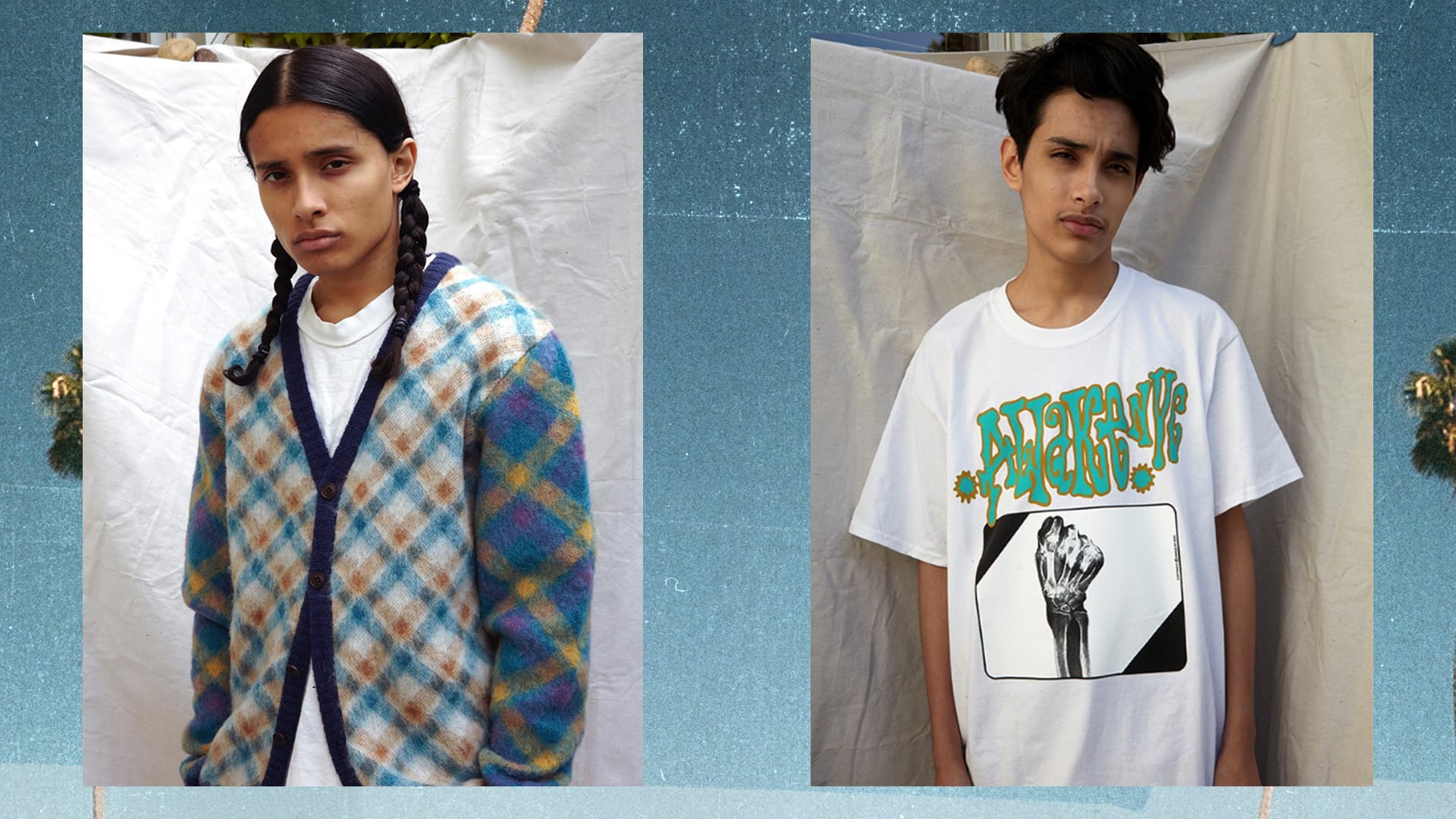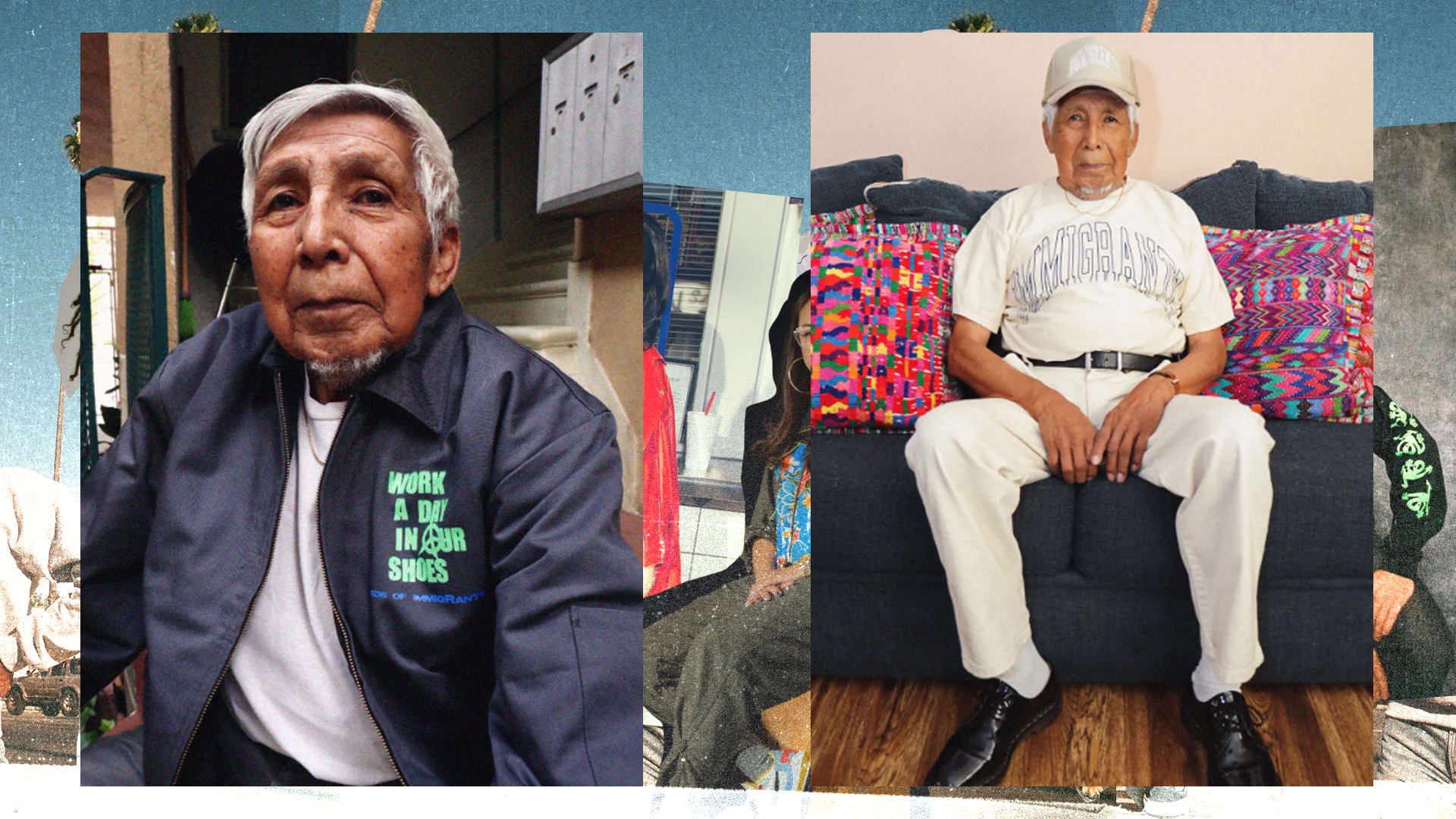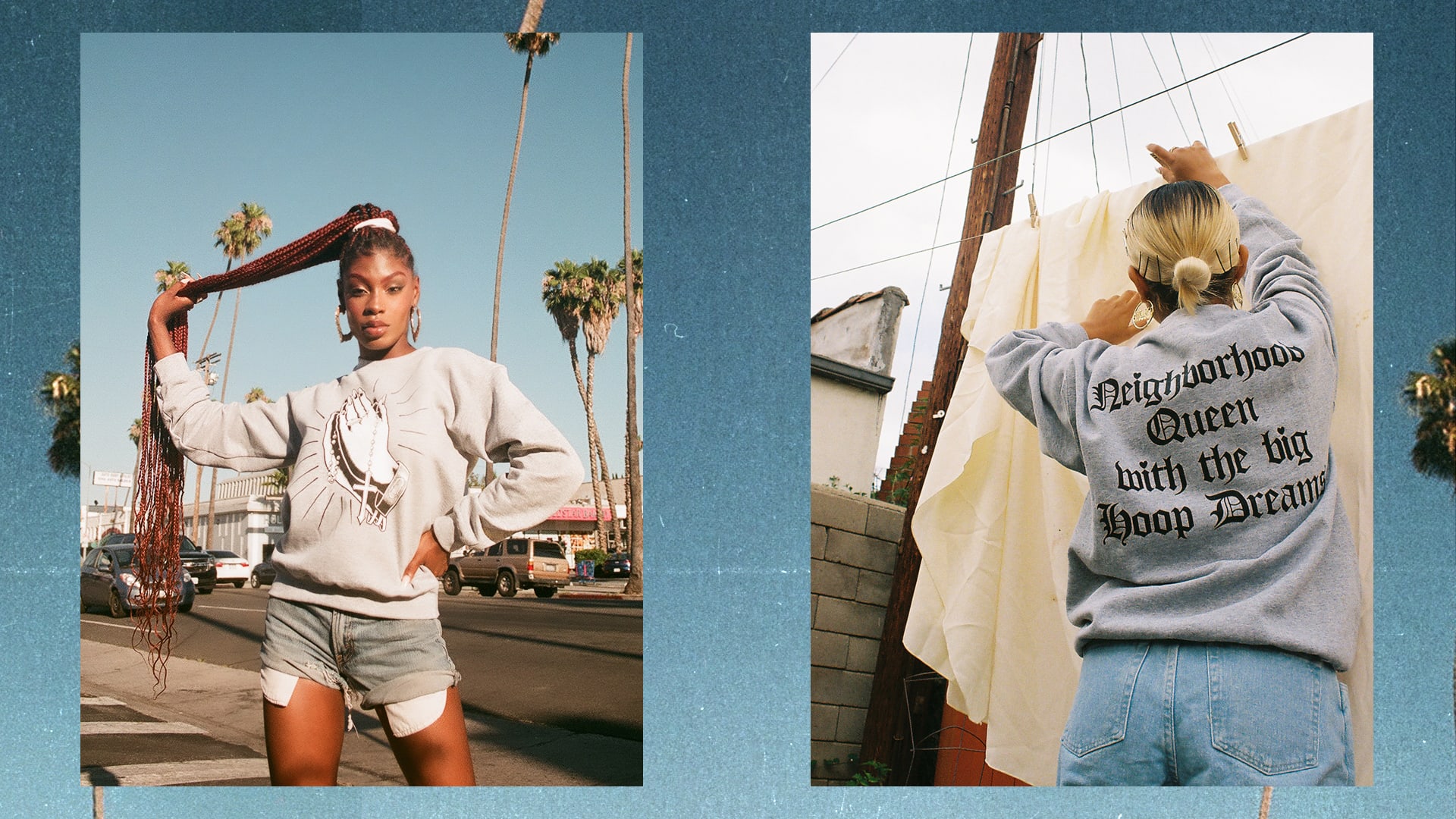October 19, 2020
Streetwear is rooted in Latinx heritage. Love the oversized, baggy look? That aesthetic was made popular by Mexican American kids in Southern California, dating back to the ’30s and ’40s with Pachucos, who were influenced by the African American community in Harlem. Since then, it’s evolved into what we now know as Cholo fashion: baggy pants, flannel shirts, bandanas, and crisp white tees—a look that’s been co-opted by several non-Latinx brands and designers. Although I could relate to seeing folks who spoke the same language as I create a subversive look born from social oppression, I never felt it represented the Latinx community as a whole.
The Latinx community in America is a melting pot of different races, dialects, cuisines, and styles. According to a recent U.S. Census Bureau report, our population reached a record of 60.6 million in 2019, up from 50.7 million in 2010. Although the growth has slowed due to a decrease in immigration and annual births from Hispanic women, the Latinx community still remains an integral part of this nation’s demographic story. And brands are starting to understand that. Recently, we’ve seen Crocs team up with Bad Bunny for his own pair of the clog shoes, which quickly sold out in 16 minutes. Following Travis Scott’s off-the-wall collab with McDonald’s, J Balvin is the latest artist to team up with the golden arches for his own curated meal. And every year Nike designs sneakers dedicated to Latinx heritage. But our story hasn’t always been fully reflected in streetwear.
“Growing up, I didn’t really have a representation that I could fully relate to, but now I have the opportunity to fill that void for the next generation,” says Angelo Baque, founder and creative director of Awake NY.

Similar to Baque, it was also challenging for me to see a reflection of myself in mainstream media growing up, let alone fashion. Born to Dominican parents, I spent most of my childhood in New Jersey before moving to Florida. Throughout middle and high school, I was exposed to brands like Rocawear, Baby Phat, Fubu, and Enyce. Brands labeled as “urban” at the time that my Black and brown friends wore. Having the chance to wear some of these pieces sparked joy, but when I learned about HLZBLZ and Married to The Mob, brands made by women and for women, my interest in streetwear grew. Still, I felt something was missing.
Like other fields, Latinx leadership in streetwear is few and far between, but the landscape is changing. Baque is part of a growing group of Latinx fashion and streetwear brands like 424 by Guillermo Andrade, Stray Rats by Julian Consegrua, Paradise.nyc by Sean Pablo, Midnight Studios by Shane Gonzales, Bella Doña by Lala Romero and Natalie Durazo, Equihua by Brenda Equihua, and Felt USA by Kristian Acosta and Louie Correa that have emerged over the past few years and represent their heritage in myriad ways. For Latinx Heritage Month, I wanted to speak with some of these designers about their brands, our culture, and the challenges they face.
Baque, who is Ecuadorian, grew up in Queens. His parents immigrated from Ecuador, and Baque says the inherent trauma that comes with being a child of immigrants is what made him seek out streetwear.
Growing up, I didn’t really have a representation that I could fully relate to, but now I have the opportunity to fill that void for the next generation.” —Angelo Baque, founder and creative director of Awake NY
“We were all the outsiders coming together in this hardship, and this struggle and pain as one,” says Baque. “It begins to transcend other relationships to friendships and a global community to bond over the love of streetwear; we were raised by the streets. Shit’s tough, and that is what drives the community. If you can survive that, you can do anything.”
The Ecuadorian creative director took his experience growing up in the melting pot of Queens to create a brand that embodies New York’s youth culture. Since its launch in 2012, Awake NY continues to capture the vibrancy and timelessness of New York City. Baque has collaborated with notable brands like Carhartt WIP, ASICS, and Moncler. Baque makes it a point to tie his brand back to his culture. Awake’s Fall 2018 collection featured a T-shirt with a flan—a popular milk-based custard dessert in Latin America. The following year, the brand released two kitchen tools that are used in Latin American culture: a tostonera used to make tostones, or fried plantain discs, and a pilon, a wooden mortar with a wooden pestle that is used to mash up ingredients. As someone who grew up watching my relatives use these tools and prepare this dessert, seeing a streetwear brand release these products tugged at the heartstrings. It made me feel seen as a Latina in streetwear.

Family is everything and more in Latinx culture. You’re taught from an early age to look out for your loved ones and give back to the community in ways that improve others’ lives. These beliefs are so ingrained into Latinx culture’s fabric, but in a fashion culture strongly tied to the hype, the spirit of unity often feels muddled, which is why Daniel Buezo co-founded Kids of Immigrants.
“I think the exclusivity of streetwear separates us,” says Buezo. “Sometimes, that doesn’t really bring community because it’s like ‘I’m cooler than you’ or ‘You ain’t got these on and you couldn’t get these.’ I’m part of it, so I understand, you know. But it’s not good when it makes people feel better than the next person or makes somebody feel lesser than the next person.”
Buezo, a Brooklyn native of Honduran descent, founded Kids of Immigrants in 2016 with Weleh Dennis, a Sacramento native whose parents are Liberian. Buezo got his start in fashion working at retailers like Banana Republic and Nordstrom. There he discovered his love for style and passion to help people. When he moved to San Francisco, Buezo met Dennis, who was designing his own leather goods. It was Dennis who inspired Buezo to design and together they launched Kids of Immigrants. Both first-generation Americans, the name seemed fitting. They started with “an intention of representing who we are, talking about our struggle, and talking about the beauty of the struggle,” Buezo tells Complex.

Since launching KOI four years ago, the brand has reclaimed the immigrant experience by building a strong and positive community around their line. “There are people who have said, ‘thank you because you have helped me be proud to be a kid of an immigrant,’” says Buezo. “I think that’s when I’m like ‘this is streetwear.’ But I also think for us, it’s bigger than streetwear. I want kids to look at what we’re doing and feel inspired. That’s when you see a shift in mentality.”
For Kristian Acosta (Kosta for short) and Louie Correa of Felt USA, they didn’t intend to be designers, but they fell into it by fate. “Louie and I wanted to start a magazine around the time we were both dropping out of college. Broke and anxious, one idea led to another, and we started talking about putting designs on T-shirts, and that eventually turned into what Felt is today.” Established in 2014, Felt (an acronym for “For Every Living Thing”) is known for its playful color palettes and fun graphics that pay homage to the ’90s. Their collections usually feature an assortment of hoodies, T-shirts, track pants, accessories, and home goods. Most recently, Felt released a line of home furnishings in collaboration with Medicom Toy—a first for the Miami-born brand.
Although they might not be vocal about their Latinidad through their designs, Kosta, whose parents are Colombian, reclaims Latinx culture’s spirit through the brand’s ethos. “When we first started Felt, it used to stand for “Fuck Everyone Lets Terrorize,” says Kosta. “Our people and culture have had everything stripped away from them, our family history, our customs, our lives, and everything in between. If you pay close attention, our graphic language has always leaned towards that sort of direction, going against the grain and whatnot. Nowadays, Felt could stand for ‘For Every Living Thing,’ but that doesn’t mean shit is sweet, nor does it mean we’ll ever stop going against the grain, against the system. We’re just forever evolving, learning, and teaching.”

Because we’re minorities, we have to work twice as hard as our white counterparts, and if you’re a woman, it makes it even more difficult, which is why Lala Romero and Natalie Durazo wanted to carve out space for their own line, Bella Doña, an LA-based streetwear brand rooted in Chicano culture.
“It was hard to maneuver in the beginning without the right connections or cosigns because, from a business and manufacturing standpoint, there is a lot to figure out,” says Romero, who built the brand with Durazo in the spirit of unity and sisterhood. “We are two best friends who come from big Latino families filled with and, more significantly, run by women. Sisterhood has opened every door and created so many beautiful opportunities for us both personally and professionally. So yes, family first is how we were raised, it also embodies how we chose to express ourselves, and fashion is, of course, a natural extension of that.”
Bella Doña’s aesthetic is about preserving the Chola style: big hoop earrings, winged eyeliner, and long nails. Their apparel nods to the richness in Mexican-American culture, incorporating religious emblems like La Virgen de Guadalupe and airbrush tees with Spanish phrases. “The only cosign that has ever truly mattered came from the girls in the neighborhoods we grew up in, our homegirls,” says Romero.
These designers subconsciously knew that staying true to themselves is what will make them stand out in an industry that’s commodified and appropriated their culture. For Brenda Equihua, founder of Mexican-American label Equihua, she’s gotten accustomed to existing in spaces that make it a challenge for her to belong due to gender and racial background.
EQUIHUA .:HERITAGE:. (Full) from 18:34 on Vimeo.
“I think one of the biggest challenges we face as minorities is that society wants to put us in a box,” says Equihua. “You could be a designer making a luxurious product that matches the quality of Chanel, but the moment the industry finds out you are a minority, they put you in the streetwear category.”
Her pieces have been worn by some of today’s biggest stars, including Bad Bunny and Young Thug. Equihua, known for her statement blanket coats that nod to Indigenous Mexican culture, doesn’t want to define the brand by an industry standard. “My focus is more about what we are saying as a brand and thinking deeply about that. I’m most concerned with translating the messages that are put out because once it reaches people, we are no longer in control of the narrative.”
Even as we see more Latinx brands come to the forefront, unfortunately, I can’t help but notice that our community’s exploitation hasn’t changed behind closed doors. Just recently, the state of California failed to pass the Garment Workers Protection Act. This law would have ensured an hourly minimum wage and closed loopholes that have allowed more than 45,000 immigrant garment workers in the state to be paid $5 an hour. Garment workers are currently being paid under the piece-rate system where workers get paid for the number of items they make, not the hours they work. NBC News reports a worker having to work 60-75 hours a week just to earn $300.
“The only cosign that has ever truly mattered came from the girls in the neighborhoods we grew up in, our homegirls.” —Lala Romero, co-founder of Bella Doña
To design full time is a luxury, says Equihua, who utilizes Latinx sewers to make her garments in Los Angeles. Latinx garment workers and full-on designers are viewed differently in the fashion industry, yet they’re similar in more ways than one. “I have always seen the artisan Latinx community as an extension of the design vs. separate from it. My family is very creative, and my mom made a lot of our clothes and accessories growing up, so I think I just believed that we were artists all along.”
Because of social media, Latinx designers no longer have to rely on major outlets for a cosign. “As long as the fashion industry is controlling the narrative, they’ll keep minorities out. They’ll let a handful of minorities into the circle, so they don’t get called racists. But, they no longer control it; the people do.”
In light of the current social and political climate, some big brands are scrambling to figure out how to engage with our community, but Buezo believes, as do I, that it has to feel authentic.
“Brands can’t sit in silence anymore and any hot product needs support from the culture,” says Buezo. “Collabs are constantly evolving and being an influencer or influential is bigger than hype now. Brands have to take a stance and work with the community.”
As much as we want to see brands tap into the Latinx community, we’re yearning for an authentic approach because of the many cultural nuances that exist and the pride we have for our bold, creative work. For Buezo, naming the brand Kids of Immigrants, was a way to speak directly to those nuances and they didn’t question whether or not brands would think the name is too limiting. “We were not fearful,” says Buezo, who recently partnered with Vans on a sneaker. “We knew our intention was pure and love. We just hoped people received it that way. We made this movement to represent, to unite, to love, and empower.”
Now, more than ever, BIPOC must claim our space in creative fields, especially during a time where police brutality against the Black community is at an all-time high, and the President tells people to go back to their countries. Seeing these brands exist creates hope because it shows that even if your parents immigrate to this country with nothing, no connections, no backups, us kids of immigrants have an opportunity to create a new, positive reality. That is how we honor our parents, our culture, our heritage.
“I am a product of immigrant parents; my cultural duty is to shed light and bring focus to those reflective of the community I came from,” says Baque. “The main objective is to raise awareness, especially in the immigrant community and those that do not have a platform to be heard.”
Share This Article
